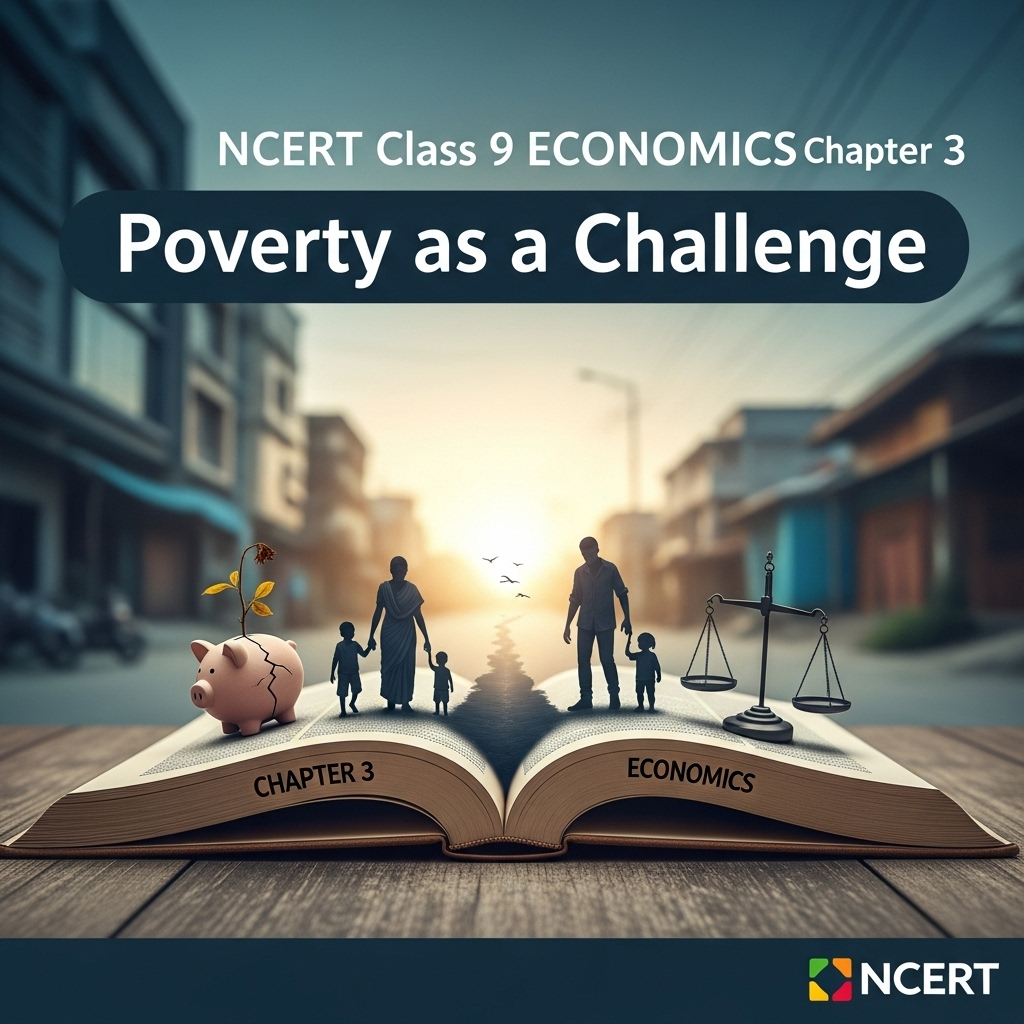Complete Solutions and Summary of Poverty as a Challenge – NCERT Class 9, Economics, Chapter 3 – Summary, Questions, Answers, Extra Questions
Detailed summary and explanation of Chapter 3 'Poverty as a Challenge' covering the multidimensional nature of poverty, indicators, measurement methods (consumption and MPI), causes, poverty estimates and reduction trends, vulnerable groups, global scenario, anti-poverty measures, and government initiatives, with all question answers and extra questions from NCERT Class IX, Economics.
Updated: 2 months ago
Categories: NCERT, Class IX, Economics, Summary, Extra Questions, Poverty, Human Development, Measurement, Vulnerable Groups, Government Schemes, Chapter 3

Poverty as a Challenge
Chapter 3: Economics - Complete Study Guide | NCERT Class 9 Notes & Questions 2025
Comprehensive Chapter Summary - Poverty as a Challenge Class 9 NCERT
Overview
- Chapter Purpose: Explores poverty as a key challenge in India, using examples, social science views, trends, causes, and government measures. Key Insight: Poverty is multi-dimensional, beyond income—includes health, education, vulnerability.
- Introduction & Cases: Poverty seen in daily life (landless laborers, jhuggis); NITI Aayog's MPI shows decline from 55% (2005-06) to 15% (2019-21). Cases: Urban (Ram Saran, low-wage mill worker, family of 6); Rural (Lakha Singh, odd jobs, family of 6, health issues). Discuss: Landlessness, unemployment, family size, literacy, health, helplessness.
- Social Scientists' View: Poverty means hunger, lack of shelter, treatment, jobs, clean water; helplessness. Indicators: Health (nutrition, mortality), Education (schooling, attendance), Living (fuel, sanitation, water, housing, electricity, assets, bank). Box: Social exclusion (caste-based), vulnerability (greater risks for backward castes, widows).
- Poverty Line: Income/consumption below minimum for basics; varies by time/place. India: Calorie-based (2400 rural, 2100 urban); revised for prices. NMPI complements with direct deprivations. Discuss: Difference between expenditure line and NMPI; local minimum level.
- Estimates: Consumption-based HCR declined 45% (1993-94) to 22% (2011-12); number ~270M. Multidimensional: 25% (2015-16) to 15% (2019-21), 13.5Cr escaped; sharper rural decline. Table 3.1: Trends; reasons for stable numbers (population growth).
- Inter-State Disparities: HCR varies (Bihar highest 34%, Kerala lowest 1%); strategies differ (Kerala: HRD, WB: land reform, AP/TN: PDS). Graph 3.1: Selected states; all-India 15%.
- Vulnerable Groups: SC/ST (43%/29%), rural ag laborers (34%), urban casual (34%). Inequality within families (women, elderly, girls). Graph 3.2: 2011-12 poverty; decline except ST.
- Global Scenario: WB $2.15/day; global fall 16% (2010) to 9% (2019). China/S Asia rapid decline (0.1%/11%); Sub-Saharan Africa high (35%). Table 3.2/Graphs 3.3-3.4: Comparisons; reasons (growth, HRD).
- SDGs: UN 17 goals by 2030; SDG1: Halve poverty. India committed. Infographics: Goals; project on achievement.
- Causes: Colonial low growth, ruined handicrafts; population boom; Green Rev limited; urban jobs insufficient; inequalities, land maldistribution; socio-cultural spending, indebtedness.
- Anti-Poverty Measures: Growth (3.5% 1970s to 6%+); targeted: MGNREGA (100 days wage, women 1/3), PM Poshan (nutrition/enrolment I-VIII), PMSMA (maternal care), PMUY (LPG for BPL women).
- Challenges: Disparities remain; broaden to human poverty (education, health, security, equality). NMPI decline due to interventions.
- Expanded Relevance 2025: Links to SDGs; post-2024 budget emphasizes social security (PMJJBY), MPI updates. Update: 11.9% India $2.15 (2021); Bihar strides.
- Exam Tip: Use cases for 5-mark on dimensions; graphs/tables for data questions.
- Broader Implications: Poverty reduction needs growth + equity; focus vulnerable, sustainable measures.
SEO Note: Why This Guide?
Top-ranked for 'Poverty as a Challenge Class 9 notes 2025'—free, with 60 Q&A from PDF, quizzes. Integrates 2023 MPI data for current affairs.
Key Themes
- Multi-Dimensional Poverty: Beyond income; 12 indicators (nutrition to bank). Decline sharper rural. India: 13.5Cr escaped 2015-21.
- Social Exclusion/Vulnerability: Cause/consequence; caste/widows face higher risks. Example: Backward castes in disasters.
- Poverty Line Debate: Calorie vs. NMPI; US car as luxury vs. India basics. Discuss: Local norms.
- Trends & Disparities: HCR fall but numbers stable till 2011; states vary (Graph 3.1). Strategies: HRD Kerala, PDS TN.
- Vulnerable Groups: SC/ST high poverty; intra-family inequality. Graph 3.2: Casual labor 34%.
- Global: S Asia/China success vs. Africa/Latin rise. Graphs: Decline areas, poor concentration.
- Causes: Colonial legacy, population, inequalities, failed reforms, socio-cultural. Green Rev: Limited impact.
- Measures: Growth + targeted (MGNREGA, PMUY); women focus. 2025 Insight: Budget Rs3L cr welfare.
- Critical Thinking: Is poverty only income? Evidence: Human poverty broader.
Cases for Exams
Ram Saran/Lakha Singh illustrate dimensions; use for 'vulnerability examples'—health, education gaps.
Exercises Summary
- Focus: Expanded to 60 Q&A from PDF: 20 short (2M), 20 medium (4M), 20 long (8M) based on NCERT Q1-13 + similar.
- Project Idea: Survey local poverty indicators; compare with NMPI.
Group Discussions
No forum posts available.


